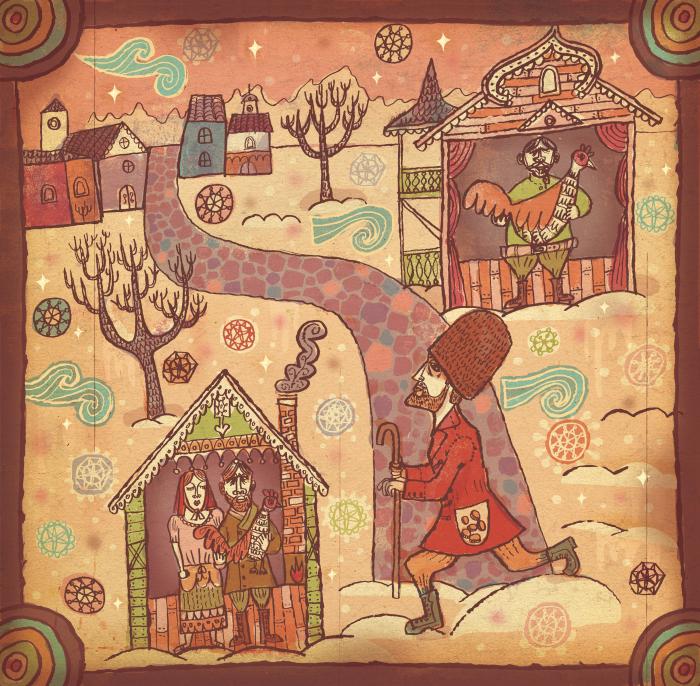Winter Tale
Chicken Soup: A Russian Tale of Giving
Story Corner
How to use Chicken Soup in the classroom
by Rhonda Thomason
Before Reading the Story
Share with students a time when you gave something away and it was easy, and a time when you gave something away and it was hard. Briefly describe how the experiences were different and the same for you. Ask students to think of similar experiences in their own lives and reflect on them. Encourage students to volunteer to share their experiences with the class.
After Reading the Story Discuss:
Both the peasant and the rich neighbor shared hospitality and food with the stranger. Did their gifts have the same meaning for the Tsar? Why?
How did the Tsar express gratitude?
The Russian Tsar wanted to learn what life was like for the people in his country. Do our nation's leaders try to understand what life is like for people here? How?
In the story, there were great differences in the resources available to each family. Is that true in our community? Why?
Does your culture value giving? How do you know?
What is the moral of this story? What does it mean to you?
Companion Activities for K-4
Ask students to either write or tell about something that they will share with someone. Then ask students to reflect on their "giving" experience verbally, in writing or through artwork.
In the story, the Tsar expresses his gratitude by giving away money. Help students explore what they are grateful for in their own lives and how they can express gratitude without using money.
Introduce students to Boker Tav (PDF), one of the songs included in Teaching Tolerance's free music anthology for the early grades, I Will Be Your Friend. The song is based on a Jewish prayer of Thanksgiving.
Ask students to reflect on what they are thankful for in their own lives and what makes them grateful for each new day. Ask students to write new verses for "Boker Tov" expressing their personal sources of gratitude.
Students can take turns reciting their verses of thanks, with the class joining in to sing the refrain. Alternately, students can perform their new song for those to whom they are grateful.
Companion Activities for Grades 5 and up
Break students into diverse small groups of four, and ask the small groups to rewrite the story from their cultures' perspectives, i.e. "Chicken Soup, An American Story of Giving," or "Chicken Soup, A Muslim Story of Giving." In it, students should carefully reflect and focus on aspects of their cultures that relate to generosity and gratitude. Encourage small groups to share their stories and discuss the similarities and differences between them.
Extension Activity
Adapt "Chicken Soup, A Russian Tale of Giving," or students' rewrites, in script form, and use them as the basis of a class play.
Bonus!
A lesson on fractions with this short story by Katie to get students thinking about fractions and how each fraction can mean something very different when considering all the parts of a the size of the whole.
Lesson:
I would begin a lesson on fractions with this short story to get students thinking about fractions and how each fraction can mean something very different when considering all the parts of a the size of the whole.
We would consider the one chicken the peasant family gave (which was the only one they owned) verses the one big fat chicken the rich man gave out of the presumably numerous chickens he owned.
For the purpose of this lesson this class the students will create chicken comparisons of their own and decide which amount is relatively larger. For example: Giving five out of ten chickens (5/10 or 1/2) or giving eight out of ten chickens (8/10 or 4/5). We could also talk about the drops of fat in the soup and consider other scenarios than the one noted in the book. For example: The Tsar could have given a gold coin for every third tiny drop of fat in a bowl of twenty-four drops (3/24 or 1/8).
Manipulatives such as drawings/pictures of chickens and soup, model chickens, or real chickens and soup could help students visualize the fractions.
I could formatively assess the students as they create their own scenarios and form the corresponding fractions.
This story also makes connections to other subjects as students can learn about Russia, Tsars, and the importance of giving and being kind.


0 комментариев
Рекомендуемые комментарии
Нет комментариев для отображения
Создайте аккаунт или войдите в него для комментирования
Вы должны быть пользователем, чтобы оставить комментарий
Создать аккаунт
Зарегистрируйтесь для получения аккаунта. Это просто!
Зарегистрировать аккаунтВойти
Уже зарегистрированы? Войдите здесь.
Войти сейчас